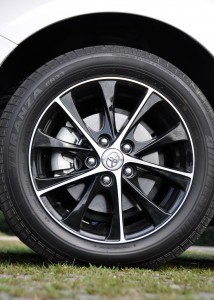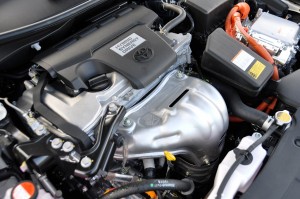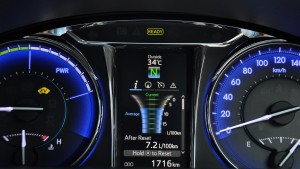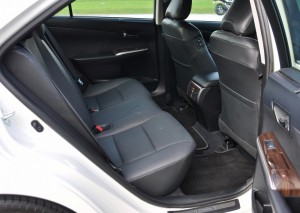Admittedly, stepping into a Toyota Camry at the crack of dawn for some early morning product snaps doesn’t quite carry the same anticipation as slipping into an 86. Like sipping a cup of Nescafe, driving a Camry has always been a familiar and comforting experience, something that can’t go wrong. But this is not any other morning, and the recently facelifted Camry has more than a few things to prove.
Falling from grace
How the current generation Camry (launched in 2012) surrendered its D-segment dominance has been nothing short of startling. Across many parts of the world, Toyota was flayed for doing too little when replacing its last generation flagship sedan. While the Camry may be a bread and butter model in terms of volume, there was no excuse in producing a replacement model that looked as boring as a piece of white bread, the slab-sided styling was more of a throwback to the 90s than “moving forward”, and on the inside, it felt no better made either. No surprise that it failed to even excite its own fans and duly became the car journalists loved to hate. The new generation Honda Accord arrived a year later in Malaysia and immediately bossed the sales chart. In 2014, it outsold the Camry by a ratio of two to one.
Rising from the ashes
 It’s a clear indication of cutthroat competitiveness when mid-life facelifts become as critical as they are today. The Camry desperately needed one and Toyota obliged. But despite the extensive rework on the outer skin, you can’t really call the makeover handsome, but at least it looks contemporary now. If anything, Toyota appeared to have tried too hard to erase any notion of conservatism, otherwise, we just can’t fathom how anyone could find those bizarre-looking alloys attractive. But hey, trying was always going to be the better option.
It’s a clear indication of cutthroat competitiveness when mid-life facelifts become as critical as they are today. The Camry desperately needed one and Toyota obliged. But despite the extensive rework on the outer skin, you can’t really call the makeover handsome, but at least it looks contemporary now. If anything, Toyota appeared to have tried too hard to erase any notion of conservatism, otherwise, we just can’t fathom how anyone could find those bizarre-looking alloys attractive. But hey, trying was always going to be the better option.
So yes, the 2015 Camry has more chrome, more slats, more cuts, more LEDs…and more interesting to look at as a result. For many, the exterior enhancements alone should drag the Camry back into their shopping lists, but there are also improvements to the interior with better plastics, subtler “wood” hues, a redesigned centre console along with new dials, higher resolution digital displays and illumination colours that would make a Christmas tree blush.
But hold on, there’s more. Underneath the surface bling is a sea of change. The 2.0-litre variants now have a brand new engine that’s not only more powerful (167PS against 150PS of old) but offers improved mileage (13.9km/l against 12.1km/l) through an intriguing mix of engineering. Toyota also took the opportunity to finally retire the four-speed auto in favour of a new six-speed (at least in the Camry), retuned the suspension, recalibrated the steering and tweaked the chassis. At this juncture, you have to say that the giant has woken up from its slumber and is now flexing its muscle. Then there is the Camry Hybrid.
You can have your kuih and eat it
 The 2.5V petrol variant is history, in its place is now the Hybrid with a 2.5-litre Atkinson cycle four-cylinder engine aided and abetted by the famed Hybrid Synergy Drive system. Top-line numbers make for interesting reading; there’s 205PS of combined system power output, but curiously no corresponding combined number for torque. On its own, the petrol engine is rated at 213Nm and the electric motor at 270Nm. It’s tempting to tally the two numbers together to get a tree-snapping total of 483Nm but peak torque of the respective components do not happen at the same time, while the state of charge of the 1.6kWh nickel metal hydride battery pack is never a constant.
The 2.5V petrol variant is history, in its place is now the Hybrid with a 2.5-litre Atkinson cycle four-cylinder engine aided and abetted by the famed Hybrid Synergy Drive system. Top-line numbers make for interesting reading; there’s 205PS of combined system power output, but curiously no corresponding combined number for torque. On its own, the petrol engine is rated at 213Nm and the electric motor at 270Nm. It’s tempting to tally the two numbers together to get a tree-snapping total of 483Nm but peak torque of the respective components do not happen at the same time, while the state of charge of the 1.6kWh nickel metal hydride battery pack is never a constant.
What we can confirm is that the petrol-electric combo works really well together, as one would expect from the leaders of hybrid technology. The electric motor fills in the torque from idle, then hands over the propulsion duties to the petrol engine when the car hits higher speeds. The transition is imperceptible and the power delivered via the CVT ’box is urgent and buttery smooth, not unlike that of a big V6, but much quieter. It’s properly quick this Camry, as in easily-laying-down-rubber-when-pulling-out-of-junction kind of quick. Based on our own estimation, it’ll do the 0-100km/h in under 8 seconds (again, no official figures shared), so expect to see a few chomping at tailgates near you.
To be perfectly fair to the Camry, it is not exactly desensitised in feel either. The steering may be geared slow to avoid excitation of body motions (there’s a battery pack sitting at the back) but once subjected to lateral loads, it does weigh up nicely, and for the supple ride it offers, the Camry can string some fast corners together without causing alarm to occupants cuddled in its plush and soft leather seats. Think composure and comfort levels of a Lexus and you’re not a million miles way. The clincher? Despite our best efforts not to drive economically, the Camry Hybrid still returned an eye-opening 14km/l.
Creeping up on the competition
Taking advantage of existing tax incentives still in place for locally assembled hybrids, Toyota has priced the Camry Hybrid at a hard-to-ignore RM174,900 (including insurance), which is about RM6,000 lower than the pre-minor change 2.5V, but now it’s loaded up with extras such as blind-spot monitoring, JBL 10-speaker audio system, Qi-wireless charging for smartphones (you’re in luck if you have a Samsung S6 or a Nexus 5), LED headlamps, GPS navigation, to name but a few. Oh, there are seven airbags now.
As owners of Toyota hybrids will tell you, you can start one up and creep in near silent electric mode to 40km/h with some deft massaging of the throttle. The trick may seem gimmicky and last no more than a couple of kilometres, but the expression from surprised bystanders is usually priceless. In a similar vein, the Honda Accord and other D-segment contenders will do well to check their rear view mirrors carefully in the coming months, the Camry is back.
Toyota Camry 2.5L Hybrid
Price RM174,900 (with insurance)
Engine 2.5L petrol, 4-cylinder
Output 160PS, 213Nm
Hybrid system Two-motor series-parallel system
Output 143PS, 270Nm
Total system output 205PS
Transmission Continuously Variable Transmission, FWD
Performance 0-100km/h in under 8 sec (est.), top speed 195km/h
Wheels/tyres 17in alloys, 215/55 R17



